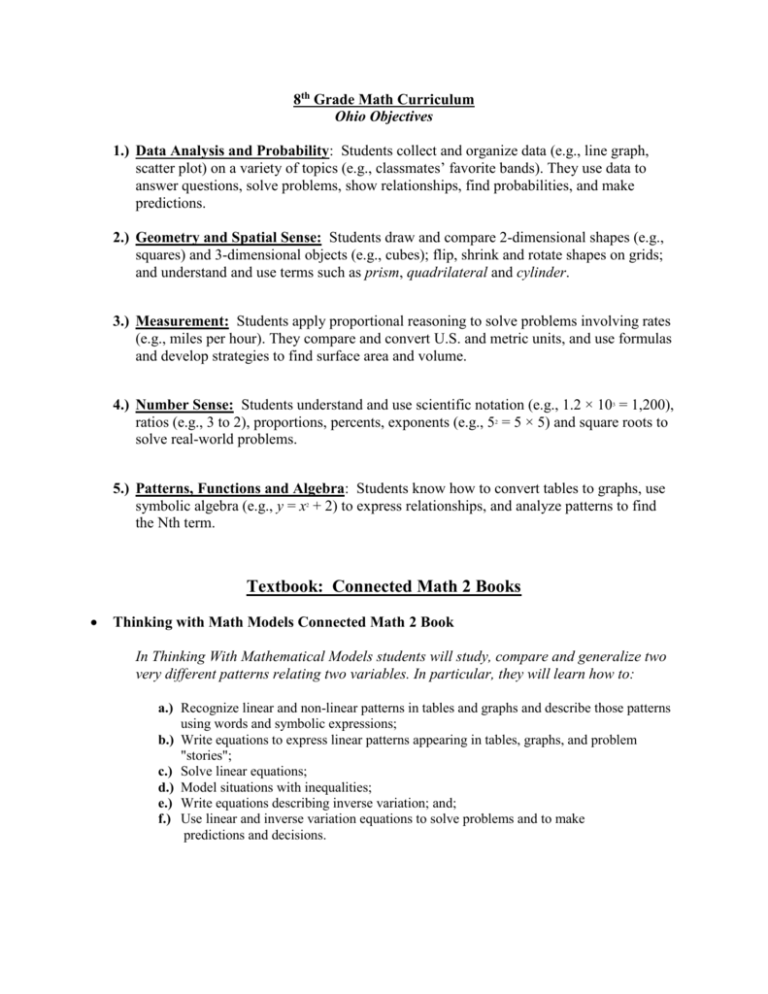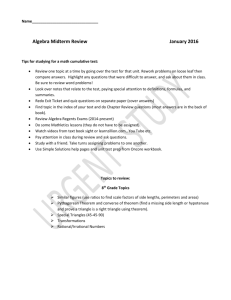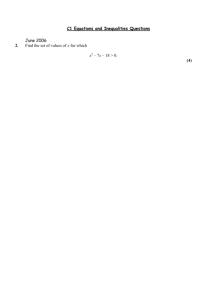Textbook: Connected Math 2 Books
advertisement

8th Grade Math Curriculum Ohio Objectives 1.) Data Analysis and Probability: Students collect and organize data (e.g., line graph, scatter plot) on a variety of topics (e.g., classmates’ favorite bands). They use data to answer questions, solve problems, show relationships, find probabilities, and make predictions. 2.) Geometry and Spatial Sense: Students draw and compare 2-dimensional shapes (e.g., squares) and 3-dimensional objects (e.g., cubes); flip, shrink and rotate shapes on grids; and understand and use terms such as prism, quadrilateral and cylinder. 3.) Measurement: Students apply proportional reasoning to solve problems involving rates (e.g., miles per hour). They compare and convert U.S. and metric units, and use formulas and develop strategies to find surface area and volume. 4.) Number Sense: Students understand and use scientific notation (e.g., 1.2 × 10 = 1,200), ratios (e.g., 3 to 2), proportions, percents, exponents (e.g., 5 = 5 × 5) and square roots to solve real-world problems. 3 2 5.) Patterns, Functions and Algebra: Students know how to convert tables to graphs, use symbolic algebra (e.g., y = x + 2) to express relationships, and analyze patterns to find the Nth term. 2 Textbook: Connected Math 2 Books Thinking with Math Models Connected Math 2 Book In Thinking With Mathematical Models students will study, compare and generalize two very different patterns relating two variables. In particular, they will learn how to: a.) Recognize linear and non-linear patterns in tables and graphs and describe those patterns using words and symbolic expressions; b.) Write equations to express linear patterns appearing in tables, graphs, and problem "stories"; c.) Solve linear equations; d.) Model situations with inequalities; e.) Write equations describing inverse variation; and; f.) Use linear and inverse variation equations to solve problems and to make predictions and decisions. Looking for Pythagoras Connected Math 2 Book In Looking for Pythagoras students explore an important relationship about right triangles that connects algebra and geometry, called the Pythagorean Theorem. They learn to: a.) b.) c.) d.) e.) Relate the area of a square to the length of a side of the square; Estimate square roots; Develop strategies for finding the distance between two points on a coordinate grid; Understand and apply the Pythagorean Theorem; and Use the Pythagorean Theorem to solve a variety of problems. Samples and Populations Connected Math 2 Book In the unit Samples and Populations students collect, organize and analyze data. They learn to: a.) Use the process of statistical investigation to explore problems; b.) Choose appropriate samples from populations and use information from samples to draw conclusions about populations c.) Explore the influence of sample size and sample selection processes in trying to obtain a sample which is likely to be predictive about the population d.) Apply concepts from probability to select random samples from populations e.) Compare sample distributions using measures of center (mean, median), measures of spread (range, least to greatest data values, percentiles), and data displays that group data (histograms, box-and-whisker plots) f.) Explore relationships between paired values of numerical attributes Shapes of Algebra Connected Math 2 Book The Shapes of Algebra was designed to help students capitalize on the strong connections between algebra and geometry in order to extend students understanding and skill in several significant aspects of those two key strands in the middle grades curriculum: a.) Determine if lines are parallel or perpendicular by looking at patterns in their graphs, vertex coordinates, and equations b.) Find midpoints of line segments and use midpoint relationships to deduce further properties of triangles and quadrilaterals c.) Write inequalities that satisfy given situations d.) Find solutions to inequalities when given a graph or an equation e.) Solve linear systems and find intersections of lines and equations through graphing, combination, and substitution f.) Write linear inequalities in two variables to match constraints in problem conditions g.) Graph linear inequalities in two variables and systems of such conditions and use the results to solve problems Growing, Growing, Growing Connected Math 2 Book Growing, Growing, Growing was created to help students make sense of exponential relationships. In this unit students will learn to: a.) Recognize situations where one variable is an exponential function of another variable; b.) Recognize the connections between exponential equations and growth patterns in tables and graphs of those relations; c.) Construct equations to express exponential patterns that appear in data tables, graphs, and problem conditions; d.) Understand and apply the rules for operating on numerical expressions with exponents; e.) Solve problems about exponential growth and decay in a variety of situations such as science or business; and f.) Compare exponential and linear relationships. Say it with Symbols Connected Math 2 Book Say It With Symbols was created to help students make sense of symbolic representations. In this unit students learn to: Model situations with symbolic statements; Write equivalent expressions; Determine if different symbolic expressions are mathematically equivalent; Interpret the information equivalent expressions represent in a given context; Determine which equivalent expression to use to answer particular questions; Solve linear equations involving parentheses; Use equations to make predictions and decisions; Scan an equation to make estimates of the patterns that would emerge in tabular or graphic representations; and i.) Understand how and when symbols should be used to display relationships, generalizations, and proof. a.) b.) c.) d.) e.) f.) g.) h.)









